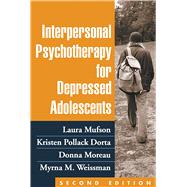
Note: Supplemental materials are not guaranteed with Rental or Used book purchases.
Purchase Benefits
What is included with this book?
| Part I. Overview | |||||
|
3 | (9) | |||
|
3 | (1) | |||
|
4 | (3) | |||
|
7 | (1) | |||
|
8 | (1) | |||
|
9 | (1) | |||
|
10 | (2) | |||
|
12 | (7) | |||
|
|||||
|
14 | (1) | |||
|
14 | (1) | |||
|
15 | (1) | |||
|
16 | (1) | |||
|
16 | (1) | |||
|
17 | (1) | |||
|
18 | (1) | |||
|
19 | (14) | |||
|
20 | (2) | |||
|
22 | (4) | |||
|
26 | (1) | |||
|
27 | (1) | |||
|
28 | (1) | |||
|
29 | (4) | |||
| Part II. Application of Interpersonal Therapy for Depressed Adolescents | |||||
|
33 | (7) | |||
|
34 | (3) | |||
|
37 | (1) | |||
|
38 | (1) | |||
|
39 | (1) | |||
|
40 | (14) | |||
|
41 | (10) | |||
|
51 | (2) | |||
|
53 | (1) | |||
|
54 | (9) | |||
|
54 | (1) | |||
|
55 | (7) | |||
|
62 | (1) | |||
|
63 | (10) | |||
|
63 | (1) | |||
|
64 | (1) | |||
|
64 | (1) | |||
|
65 | (3) | |||
|
68 | (4) | |||
|
72 | (1) | |||
|
73 | (9) | |||
|
73 | (1) | |||
|
74 | (4) | |||
|
78 | (2) | |||
|
80 | (2) | |||
|
82 | (28) | |||
|
82 | (3) | |||
|
85 | (3) | |||
|
88 | (6) | |||
|
94 | (10) | |||
|
104 | (2) | |||
|
106 | (4) | |||
|
110 | (16) | |||
|
110 | (2) | |||
|
112 | (8) | |||
|
120 | (1) | |||
|
120 | (2) | |||
|
122 | (4) | |||
|
126 | (17) | |||
|
128 | (1) | |||
|
129 | (8) | |||
|
137 | (1) | |||
|
138 | (5) | |||
|
143 | (22) | |||
|
144 | (2) | |||
|
146 | (1) | |||
|
147 | (2) | |||
|
149 | (3) | |||
|
152 | (4) | |||
|
156 | (4) | |||
|
160 | (1) | |||
|
161 | (4) | |||
|
165 | (14) | |||
|
166 | (1) | |||
|
167 | (7) | |||
|
174 | (2) | |||
|
176 | (3) | |||
|
179 | (24) | |||
|
180 | (9) | |||
|
189 | (3) | |||
|
192 | (5) | |||
|
197 | (1) | |||
|
197 | (2) | |||
|
199 | (4) | |||
| Part III. Special Issues in Treating Adolescents | |||||
|
203 | (13) | |||
|
203 | (4) | |||
|
207 | (5) | |||
|
212 | (1) | |||
|
213 | (3) | |||
|
216 | (11) | |||
|
216 | (1) | |||
|
217 | (2) | |||
|
219 | (1) | |||
|
220 | (1) | |||
|
221 | (1) | |||
|
222 | (2) | |||
|
224 | (1) | |||
|
224 | (1) | |||
|
225 | (1) | |||
|
225 | (1) | |||
|
226 | (1) | |||
|
227 | (7) | |||
|
227 | (2) | |||
|
229 | (4) | |||
|
233 | (1) | |||
|
234 | (9) | |||
|
234 | (1) | |||
|
235 | (2) | |||
|
237 | (1) | |||
|
238 | (4) | |||
|
242 | (1) | |||
|
243 | (8) | |||
|
243 | (3) | |||
|
246 | (1) | |||
|
247 | (2) | |||
|
249 | (1) | |||
|
249 | (1) | |||
|
250 | (1) | |||
|
251 | (28) | |||
|
251 | (1) | |||
|
252 | (10) | |||
|
262 | (10) | |||
|
272 | (3) | |||
|
275 | (4) | |||
| Appendix A. Closeness Circle | 279 | (2) | |||
| Appendix B. Interpersonal Inventory: How to Query about Relationships | 281 | (4) | |||
| Appendix C. Session Checklists for Interpersonal Therapy for Depressed Adolescents | 285 | (6) | |||
| References | 291 | (16) | |||
| Index | 307 |
The New copy of this book will include any supplemental materials advertised. Please check the title of the book to determine if it should include any access cards, study guides, lab manuals, CDs, etc.
The Used, Rental and eBook copies of this book are not guaranteed to include any supplemental materials. Typically, only the book itself is included. This is true even if the title states it includes any access cards, study guides, lab manuals, CDs, etc.